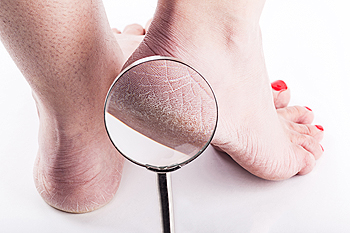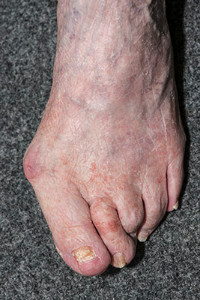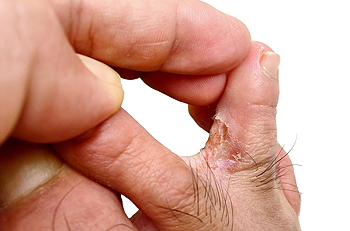Items filtered by date: March 2020
What Can Cause Cracked Heels?
 A common reason for the condition that is known as cracked heels to develop is having excessively dry skin. This can happen as a result of residing in cold environments, wearing shoes that have an open back, or from standing for the majority of the day. Additionally, existing medical conditions may contribute to the formation of cracked heels. These can include psoriasis and eczema, which are known to cause patches of dry skin. Patients have found mild relief when their feet are washed and dried daily, followed by thoroughly applying a good moisturizer. It may help to file the cracked skin away, in addition to wearing socks that are made of natural materials. If you have cracked heels, it is suggested that you speak with a podiatrist for effective treatment methods.
A common reason for the condition that is known as cracked heels to develop is having excessively dry skin. This can happen as a result of residing in cold environments, wearing shoes that have an open back, or from standing for the majority of the day. Additionally, existing medical conditions may contribute to the formation of cracked heels. These can include psoriasis and eczema, which are known to cause patches of dry skin. Patients have found mild relief when their feet are washed and dried daily, followed by thoroughly applying a good moisturizer. It may help to file the cracked skin away, in addition to wearing socks that are made of natural materials. If you have cracked heels, it is suggested that you speak with a podiatrist for effective treatment methods.
Cracked heels are unsightly and can cause further damage to your shoes and feet. If you have any concerns, contact Elliot T. Udell, DPM from New York. Our doctor can provide the care you need to keep you pain-free and on your feet.
Cracked Heels
Cracked heels appear unappealing and can make it harder for you walk around in sandals. Aside from looking unpleasant, cracked heels can also tear stockings, socks, and wear out your shoes. There are several methods to help restore a cracked heel and prevent further damage.
How Do You Get Them?
Dry skin is the number one culprit in creating cracked heels. Many athletes, walkers, joggers, and even swimmers suffer from cracked heels. Age and skin oil production play a role to getting cracked heels as well.
Promote Healing
Over the counter medicines can help, especially for those that need instant relief or who suffer from chronic dry feet.
Wear Socks – Wearing socks with medicated creams helps lock in moisture.
Moisturizers – Applying both day and night will help alleviate dryness which causes cracking.
Pumice Stones – These exfoliate and remove dead skin, which allows for smoother moisturizer application and better absorption into the skin.
Change in Diet
Eating healthy with a well-balanced diet will give the skin a fresh and radiant look. Your body responds to the kinds of food you ingest. Omega-3 fatty acids and zinc supplements can also revitalize skin tissue.
Most importantly, seek professional help if unsure how to proceed in treating cracked heels. A podiatrist will help you with any questions or information needed.
If you have any questions, please feel free to contact our office located in Hicksville, NY . We offer the newest diagnostic and treatment technologies for all your foot care needs.
What Can Cause a Bunion to Develop?
 A bunion is considered to be a bone disorder that can gradually get worse. It appears as a bony protrusion on the side of the big toe, and larger shoes may need to be worn that can accommodate the growing bunion. It generally develops as a result of genetic factors, or from wearing shoes that do not have adequate room for the toes to move freely in. Additionally, existing medical conditions including flat feet and specific types of arthritis, may contribute to the development of a bunion. In severe cases, calluses may form on top of the bunion, and friction may cause this to happen. Some of the symptoms that are associated with this condition may include a numbing or burning sensation, and it may be difficult to move the affected toe. If you have signs of a bunion, it is suggested that you consult with a podiatrist who can guide you toward the correct treatment options.
A bunion is considered to be a bone disorder that can gradually get worse. It appears as a bony protrusion on the side of the big toe, and larger shoes may need to be worn that can accommodate the growing bunion. It generally develops as a result of genetic factors, or from wearing shoes that do not have adequate room for the toes to move freely in. Additionally, existing medical conditions including flat feet and specific types of arthritis, may contribute to the development of a bunion. In severe cases, calluses may form on top of the bunion, and friction may cause this to happen. Some of the symptoms that are associated with this condition may include a numbing or burning sensation, and it may be difficult to move the affected toe. If you have signs of a bunion, it is suggested that you consult with a podiatrist who can guide you toward the correct treatment options.
If you are suffering from bunions, contact Elliot T. Udell, DPM of New York. Our doctor can provide the care you need to keep you pain-free and on your feet.
What Is a Bunion?
A bunion is formed of swollen tissue or an enlargement of boney growth, usually located at the base joint of the toe that connects to the foot. The swelling occurs due to the bones in the big toe shifting inward, which impacts the other toes of the foot. This causes the area around the base of the big toe to become inflamed and painful.
Why Do Bunions Form?
Genetics – Susceptibility to bunions are often hereditary
Stress on the feet – Poorly fitted and uncomfortable footwear that places stress on feet, such as heels, can worsen existing bunions
How Are Bunions Diagnosed?
Doctors often perform two tests – blood tests and x-rays – when trying to diagnose bunions, especially in the early stages of development. Blood tests help determine if the foot pain is being caused by something else, such as arthritis, while x-rays provide a clear picture of your bone structure to your doctor.
How Are Bunions Treated?
- Refrain from wearing heels or similar shoes that cause discomfort
- Select wider shoes that can provide more comfort and reduce pain
- Anti-inflammatory and pain management drugs
- Orthotics or foot inserts
- Surgery
If you have any questions, please feel free to contact our office located in Hicksville, NY . We offer the newest diagnostic and treatment technologies for all your foot care needs.
What Factors Contribute to Tarsal Tunnel Syndrome?
 If you feel a tingling, burning, or numbing sensation in your feet, you may be experiencing symptoms related to a foot condition known as tarsal tunnel syndrome. With this condition, pain is typically felt in the sole, heel, and arch areas of the foot. Some patients who have had this condition also say they experienced a sensation that feels like pins and needles in the feet. Tarsal tunnel syndrome may develop when the posterior tibial nerve becomes compressed or pinched. Other reasons for its development may include osteoarthritis, rheumatoid arthritis, and diabetes. To help alleviate pain, it may be beneficial to perform light stretches that focus on strengthening the calf muscles. For more advice on how to treat this ailment, it’s suggested that you speak with a podiatrist for a proper diagnosis and professional care.
If you feel a tingling, burning, or numbing sensation in your feet, you may be experiencing symptoms related to a foot condition known as tarsal tunnel syndrome. With this condition, pain is typically felt in the sole, heel, and arch areas of the foot. Some patients who have had this condition also say they experienced a sensation that feels like pins and needles in the feet. Tarsal tunnel syndrome may develop when the posterior tibial nerve becomes compressed or pinched. Other reasons for its development may include osteoarthritis, rheumatoid arthritis, and diabetes. To help alleviate pain, it may be beneficial to perform light stretches that focus on strengthening the calf muscles. For more advice on how to treat this ailment, it’s suggested that you speak with a podiatrist for a proper diagnosis and professional care.
Tarsal tunnel syndrome can be very uncomfortable to live with. If you are experiencing tarsal tunnel syndrome, contact Elliot T. Udell, DPM of New York. Our doctor can provide the care you need to keep you pain-free and on your feet.
Tarsal Tunnel Syndrome
Tarsal tunnel syndrome, which can also be called tibial nerve dysfunction, is an uncommon condition of misfiring peripheral nerves in the foot. The tibial nerve is the peripheral nerve in the leg responsible for sensation and movement of the foot and calf muscles. In tarsal tunnel syndrome, the tibial nerve is damaged, causing problems with movement and feeling in the foot of the affected leg.
Common Cause of Tarsal Tunnel Syndrome
- Involves pressure or an injury, direct pressure on the tibial nerve for an extended period of time, sometimes caused by other body structures close by or near the knee.
- Diseases that damage nerves, including diabetes, may cause tarsal tunnel syndrome.
- At times, tarsal tunnel syndrome can appear without an obvious cause in some cases.
The Effects of Tarsal Tunnel Syndrome
- Different sensations, an afflicted person may experience pain, tingling, burning or other unusual sensations in the foot of the affected leg.
- The foot muscles, toes and ankle become weaker, and curling your toes or flexing your foot can become difficult.
- If condition worsens, infections and ulcers may develop on the foot that is experiencing the syndrome.
A physical exam of the leg can help identify the presence of tarsal tunnel syndrome. Medical tests, such as a nerve biopsy, are also used to diagnose the condition. Patients may receive physical therapy and prescriptive medication. In extreme cases, some may require surgery.
If you have any questions please feel free to contact our office located in Hicksville, NY . We offer the newest diagnostic and treatment technologies for all your foot and ankle needs.
Wearing High Heels While Working
 Many patients experience foot pain at the end of their working day. This may be a result of wearing shoes that do not fit correctly, or it may come from standing for extended periods of time throughout the day. Some work environments require high heels to be worn. If this is true for you, it may be beneficial to wear the lowest heel that is acceptable in the work environment, in addition to frequently stretching the calf muscles during the day. Additionally, it may be favorable to wear shoes that are made of breathable materials, and to alternate them with another pair, as this may help to avoid discomfort. If you would like additional information about how to protect your feet while working, please schedule an appointment with a podiatrist.
Many patients experience foot pain at the end of their working day. This may be a result of wearing shoes that do not fit correctly, or it may come from standing for extended periods of time throughout the day. Some work environments require high heels to be worn. If this is true for you, it may be beneficial to wear the lowest heel that is acceptable in the work environment, in addition to frequently stretching the calf muscles during the day. Additionally, it may be favorable to wear shoes that are made of breathable materials, and to alternate them with another pair, as this may help to avoid discomfort. If you would like additional information about how to protect your feet while working, please schedule an appointment with a podiatrist.
While working on the feet, it is important to take the proper care of them. For more information about working on your feet, contact Elliot T. Udell, DPM from New York. Our doctor will treat your foot and ankle needs.
Working on Your Feet
Standing on your feet for long periods of time can cause stress and pain in your feet. Your whole body may experience change in terms of posture, back pain, bunions, callouses and or plantar warts. There are ways to avoid these conditions with proper foot care, smart choices and correct posture.
Positive Changes
Negative heeled shoe – Choosing this shoe type places the heel slightly lower than the ball of the foot. These are great for overall foot health. Find shoes that fit you correctly.
Go barefoot – Our feet were not designed to be enclosed for all hours of the day. Try to periodically expose your feet to air.
Eliminate Pain
Foot Exercises – Performing simple exercises, incorporating yoga and doing stretches are beneficial. This will allow increased blood flow to the area and muscles of the foot.
Achilles tendon – Stretching the foot out flat on the floor will relax the calf muscles and tendon. These exercises can be performed almost anywhere. Make sure you add these exercises to your daily regimen.
With a little bit of this information and knowing more about foot health, you will notice changes. Foot stretches and proper footwear will help with pain and prevent further issues.
If you have any questions please feel free to contact our office located in Hicksville, NY . We offer the newest diagnostic and treatment technologies for all your foot and ankle needs.
How Can You Tell If Athlete’s Foot Has Developed
There are clear signs that can indicate whether athlete's foot has developed or not. A common symptom related to this condition is the formation of a red rash that may spread all over the afflicted foot and is normally found in between the toes. If left untreated, the rash may spread underneath the foot, leaving the skin looking scaly or chalky. Additionally, the rash may be incredibly itchy, however, scratching the affected area may cause more harm to the skin, which is why it is advised that scratching be refrained. Athlete’s foot is a fungal skin infection that may enter the skin if footwear is not worn in warm, moist environments. Areas where this infection typically spreads can include communal showers, locker rooms, and swimming pools. For advice on how to treat your athlete’s foot or for tips on prevention, we recommend you consult with a podiatrist for professional care.
Athlete’s Foot
Athlete’s foot is often an uncomfortable condition to experience. Thankfully, podiatrists specialize in treating athlete’s foot and offer the best treatment options. If you have any questions about athlete’s foot, consult with Elliot T. Udell, DPM from New York. Our doctor will assess your condition and provide you with quality treatment.
What Is Athlete’s Foot?
Tinea pedis, more commonly known as athlete’s foot, is a non-serious and common fungal infection of the foot. Athlete’s foot is contagious and can be contracted by touching someone who has it or infected surfaces. The most common places contaminated by it are public showers, locker rooms, and swimming pools. Once contracted, it grows on feet that are left inside moist, dark, and warm shoes and socks.
Prevention
The most effective ways to prevent athlete’s foot include:
- Thoroughly washing and drying feet
- Avoid going barefoot in locker rooms and public showers
- Using shower shoes in public showers
- Wearing socks that allow the feet to breathe
- Changing socks and shoes frequently if you sweat a lot
Symptoms
Athlete’s foot initially occurs as a rash between the toes. However, if left undiagnosed, it can spread to the sides and bottom of the feet, toenails, and if touched by hand, the hands themselves. Symptoms include:
- Redness
- Burning
- Itching
- Scaly and peeling skin
Diagnosis and Treatment
Diagnosis is quick and easy. Skin samples will be taken and either viewed under a microscope or sent to a lab for testing. Sometimes, a podiatrist can diagnose it based on simply looking at it. Once confirmed, treatment options include oral and topical antifungal medications.
If you have any questions, please feel free to contact our office located in Hicksville, NY . We offer the newest diagnostic and treatment technologies for all your foot care needs.


